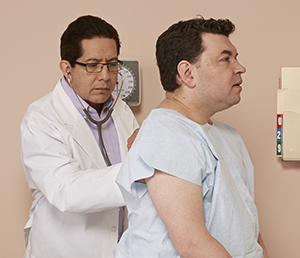Diagnosing COPD
Diagnosing COPD
Your healthcare provider will use your past health history, a physical exam, and certain tests to diagnose COPD.
Health history
Your healthcare provider learns about your health history by asking questions. Topics include:
History of present illness. Tell your healthcare provider about your symptoms. Also tell him or her how long you have had them.
Past medical and surgical history. Share other health problems and surgery you have had.
Family history. Report serious health problems in close family members. This is especially true of any lung problems.
Social and environmental history. The most important factor in COPD is whether you smoke or have smoked in the past. You should also tell your provider if you have been around secondhand smoke, harmful chemicals, or air pollution.
Functional assessment. Report whether breathing gets in the way of your daily activities.
Physical exam
Your provider will examine you. He or she will check your heart and lungs with a stethoscope. The focus will be on your airways, including your nose and throat.
Diagnostic tests
Pulmonary function tests measure the flow of air into and out of your lungs. They also check how much air your lungs can hold. The most common pulmonary function test is spirometry. This measures how fast and how much air you can blow out (exhale). This test is important to help diagnose COPD.
Pulse oximetry shows how much oxygen is in your blood (oxygen saturation). This may be done at rest. It may also be done during and after exercise.
Arterial blood gas tests measure levels of oxygen and carbon dioxide in your blood.
Chest X-rays show the size and shape of your lungs. They can also show certain problems in the lungs.
CT scans show detailed images of the lungs.
Updated:
March 21, 2017
Sources:
Diagnosis and Management of Stable Chronic Obstructive Pulmonary Disease. A Clinical Practice Guidelines. Qaseem A. Annals of Internal Medicine. 2011;155(3):s179-91.
Reviewed By:
Blaivas, Allen J, DO,Ziegler, Olivia, MS, PA
